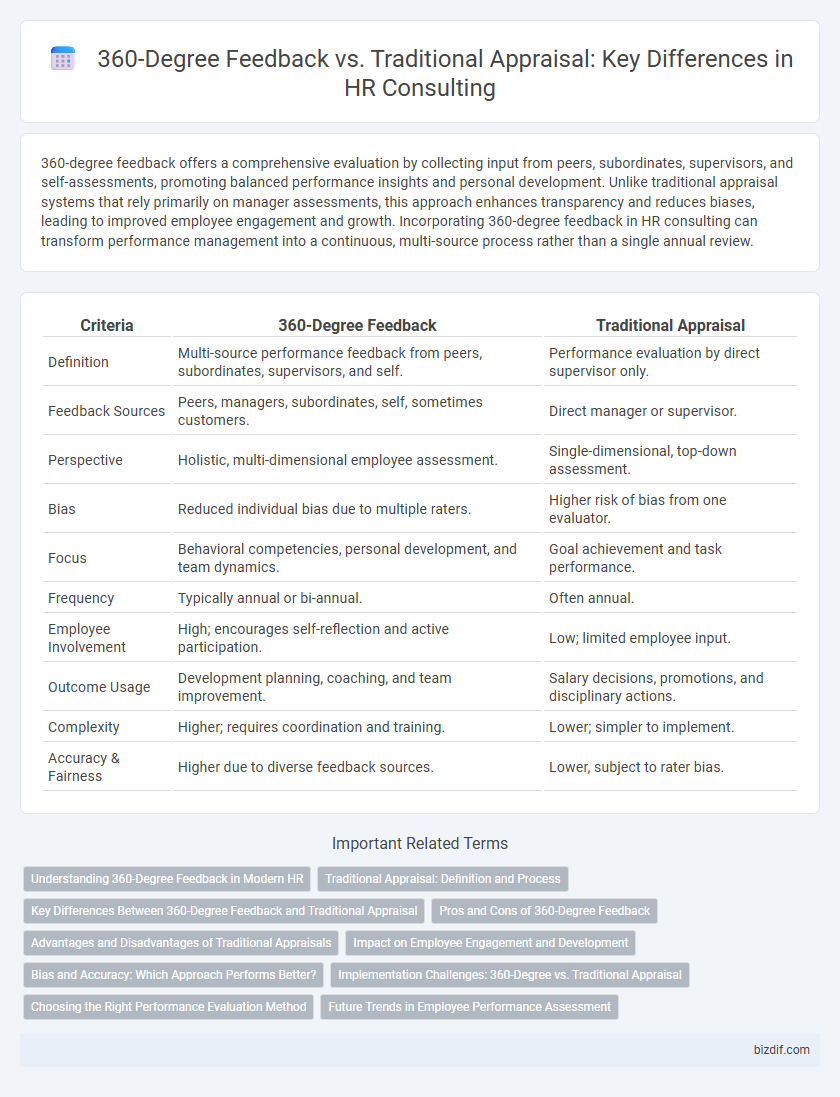360-degree feedback offers a comprehensive evaluation by collecting input from peers, subordinates, supervisors, and self-assessments, promoting balanced performance insights and personal development. Unlike traditional appraisal systems that rely primarily on manager assessments, this approach enhances transparency and reduces biases, leading to improved employee engagement and growth. Incorporating 360-degree feedback in HR consulting can transform performance management into a continuous, multi-source process rather than a single annual review.
Table of Comparison
| Criteria | 360-Degree Feedback | Traditional Appraisal |
|---|---|---|
| Definition | Multi-source performance feedback from peers, subordinates, supervisors, and self. | Performance evaluation by direct supervisor only. |
| Feedback Sources | Peers, managers, subordinates, self, sometimes customers. | Direct manager or supervisor. |
| Perspective | Holistic, multi-dimensional employee assessment. | Single-dimensional, top-down assessment. |
| Bias | Reduced individual bias due to multiple raters. | Higher risk of bias from one evaluator. |
| Focus | Behavioral competencies, personal development, and team dynamics. | Goal achievement and task performance. |
| Frequency | Typically annual or bi-annual. | Often annual. |
| Employee Involvement | High; encourages self-reflection and active participation. | Low; limited employee input. |
| Outcome Usage | Development planning, coaching, and team improvement. | Salary decisions, promotions, and disciplinary actions. |
| Complexity | Higher; requires coordination and training. | Lower; simpler to implement. |
| Accuracy & Fairness | Higher due to diverse feedback sources. | Lower, subject to rater bias. |
Understanding 360-Degree Feedback in Modern HR
360-degree feedback in modern HR involves gathering performance insights from multiple sources, including peers, subordinates, supervisors, and self-assessments, providing a comprehensive evaluation compared to traditional appraisal methods that rely primarily on supervisor reviews. This multi-source feedback approach enhances employee development, promotes self-awareness, and supports a culture of continuous improvement by highlighting diverse perspectives on performance. Implementing 360-degree feedback helps organizations align performance management with leadership development and talent retention strategies effectively.
Traditional Appraisal: Definition and Process
Traditional appraisal is a performance evaluation method where managers assess employees based on predetermined criteria, often through annual or semi-annual reviews. The process typically involves setting clear objectives, measuring performance against these goals, and providing feedback primarily from a single supervisor. This approach emphasizes hierarchical judgment, making it straightforward but sometimes limited in capturing a comprehensive view of an employee's competencies.
Key Differences Between 360-Degree Feedback and Traditional Appraisal
360-degree feedback involves collecting performance evaluations from multiple sources including peers, subordinates, and supervisors, whereas traditional appraisal relies primarily on a single manager's assessment. This multi-source feedback provides a more comprehensive view of an employee's skills, behaviors, and impact, enhancing developmental insights and reducing bias found in traditional appraisals. Traditional appraisals often focus on evaluating past performance against set objectives, while 360-degree feedback emphasizes continuous improvement and personal growth through diverse perspectives.
Pros and Cons of 360-Degree Feedback
360-degree feedback in HR consulting offers a comprehensive evaluation by gathering input from multiple sources including peers, subordinates, and supervisors, which enhances self-awareness and promotes balanced development. However, the process can be time-consuming, costly, and may lead to biased or conflicting feedback if not managed objectively. Unlike traditional appraisals that rely on a single supervisor's perspective, 360-degree feedback fosters a more holistic view but requires careful implementation to mitigate potential challenges.
Advantages and Disadvantages of Traditional Appraisals
Traditional appraisals provide a structured evaluation method focusing on individual performance metrics, making it easier to set clear goals and track progress over time. This approach often lacks comprehensive feedback, potentially leading to bias and limited employee development insights compared to 360-degree feedback. However, traditional appraisals are typically less time-consuming and require fewer resources, making them more straightforward to implement in large organizations.
Impact on Employee Engagement and Development
360-degree feedback enhances employee engagement by providing comprehensive insights from peers, subordinates, and supervisors, fostering a culture of open communication and continuous development. This holistic approach accelerates skill improvement and personal growth, compared to traditional appraisals that often rely on singular managerial perspectives. Data shows organizations employing 360-degree feedback experience higher employee satisfaction and retention rates, directly influencing performance and innovation.
Bias and Accuracy: Which Approach Performs Better?
360-degree feedback reduces bias by incorporating evaluations from multiple sources, including peers, subordinates, and supervisors, leading to a more comprehensive and accurate assessment of employee performance. Traditional appraisals often suffer from manager bias and limited perspective, which can undermine accuracy and fairness. Studies show that 360-degree feedback enhances performance accuracy by capturing diverse viewpoints, making it a more reliable method compared to conventional single-source evaluations.
Implementation Challenges: 360-Degree vs. Traditional Appraisal
Implementing 360-degree feedback often faces challenges such as ensuring anonymity, managing extensive data collection, and providing consistent training for evaluators, which can be resource-intensive compared to traditional appraisals. Traditional appraisal systems primarily struggle with evaluator bias and limited perspectives, offering a narrower view that is easier to administer but less comprehensive. Overcoming resistance to change and integrating 360-degree feedback effectively requires careful planning and robust technology solutions to support a multidimensional evaluation process.
Choosing the Right Performance Evaluation Method
Choosing the right performance evaluation method depends on organizational goals and employee development needs. 360-degree feedback provides comprehensive insights by collecting input from peers, subordinates, and supervisors, enhancing self-awareness and promoting continuous growth. Traditional appraisal, while simpler and quicker, often lacks multidimensional perspectives but works well for straightforward performance assessments and compliance purposes.
Future Trends in Employee Performance Assessment
360-degree feedback leverages multi-source insights from peers, managers, and subordinates, enhancing comprehensive employee performance evaluation compared to traditional top-down appraisals. Emerging trends emphasize continuous, real-time feedback enabled by AI-driven performance analytics, supporting agile talent management and personalized development plans. Integrating advanced data visualization and sentiment analysis tools further refines the accuracy and actionable insights, driving future-ready HR consulting strategies.
360-degree feedback vs traditional appraisal Infographic

 bizdif.com
bizdif.com